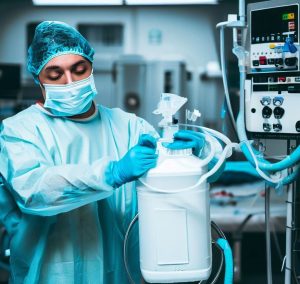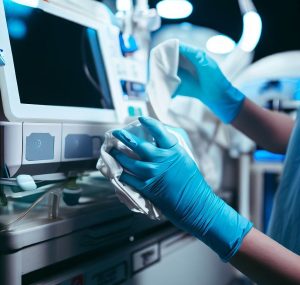From Chemical to Physical, Exploring Comprehensive Disinfection Strategies
In the intensive care unit (ICU), where critically ill patients with compromised immune systems are treated, effective disinfection is paramount to prevent the spread of infections. The ICU environment requires meticulous attention to disinfection practices due to the high-risk nature of the patients and the potential for cross-contamination.
The variety of disinfection methods employed in the ICU, both chemical and physical, emphasizes their importance in effective infection control.
Chemical Disinfection Methods
Chemical disinfection methods involve the use of disinfectants to eliminate microorganisms on surfaces and medical equipment. Commonly used disinfectants include chlorine compounds, alcohols, and hydrogen peroxide. Chlorine compounds, such as sodium hypochlorite, are effective against a broad spectrum of pathogens and are widely used for surface disinfection. Alcohols, such as isopropyl alcohol, are commonly used for hand sanitization and disinfection of small equipment. Hydrogen peroxide, in its vaporized form, is utilized for room decontamination. These chemical disinfectants are applied following specific instructions regarding concentration, contact time, and compatibility with the materials being disinfected.

Physical Disinfection Methods
Physical disinfection methods employ heat or radiation to destroy or inactivate microorganisms. In the ICU, physical disinfection is often accomplished through techniques such as moist heat sterilization, dry heat sterilization, and ultraviolet (UV) disinfection. Moist heat sterilization, achieved through autoclaves, utilizes high-pressure steam to eradicate microorganisms from heat-resistant medical instruments. Dry heat sterilization involves the use of hot air ovens to achieve sterilization. UV disinfection employs UV-C radiation to disrupt the DNA of microorganisms, rendering them unable to replicate. These physical disinfection methods offer effective alternatives for specific equipment and surfaces in the ICU.

Importance of Disinfection Protocols and Standard Operating Procedures
Implementing disinfection protocols and adhering to standard operating procedures (SOPs) are crucial in the ICU to maintain consistency and efficiency in the disinfection process. SOPs should cover key areas such as pre-cleaning, regular disinfection, and emergency disinfection. Pre-cleaning involves thorough removal of organic material and visible debris before disinfection. Regular disinfection includes scheduled disinfection of surfaces, equipment, and patient care areas. Emergency disinfection procedures are employed in response to contamination incidents or outbreaks. Strict adherence to disinfection protocols and SOPs ensures a systematic approach to infection control in the ICU.
Advanced Disinfection Technologies
With advancements in technology, the ICU can benefit from innovative disinfection technologies that enhance the effectiveness and efficiency of disinfection practices. Automated disinfection systems, such as robotic devices equipped with UV-C emitters, can efficiently disinfect large areas within the ICU, reducing human error and saving time. Additionally, the use of hydrogen peroxide vapor or aerosolized disinfectants provides a comprehensive approach to room decontamination, reaching areas that may be difficult to clean manually. These advanced disinfection technologies complement traditional methods, ensuring a more thorough and reliable disinfection process in the ICU.
In the ICU, where vulnerable patients are at a high risk of infections, effective disinfection methods are essential for maintaining a safe environment and preventing healthcare-associated infections. Both chemical and physical disinfection methods, supported by standardized protocols and advanced technologies, contribute to robust infection control practices. By understanding the importance of disinfection protocols, healthcare professionals can optimize their efforts to ensure effective ICU disinfection. Implementing comprehensive disinfection strategies in the ICU serves as a crucial line of defense in safeguarding patient well-being and reducing the transmission of infections.